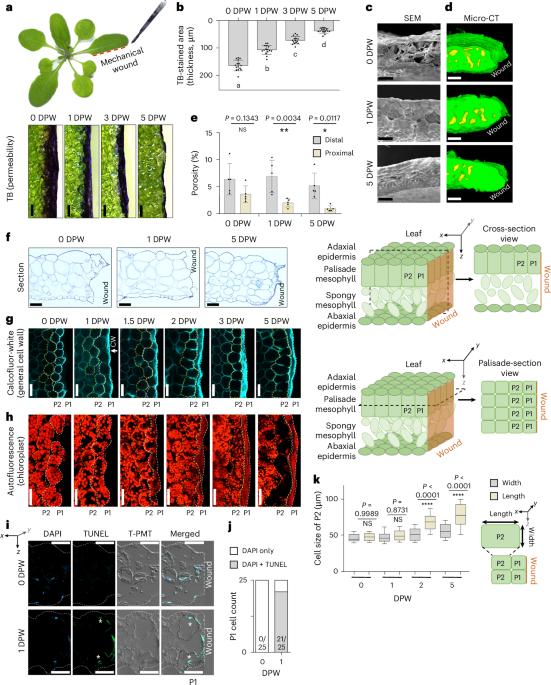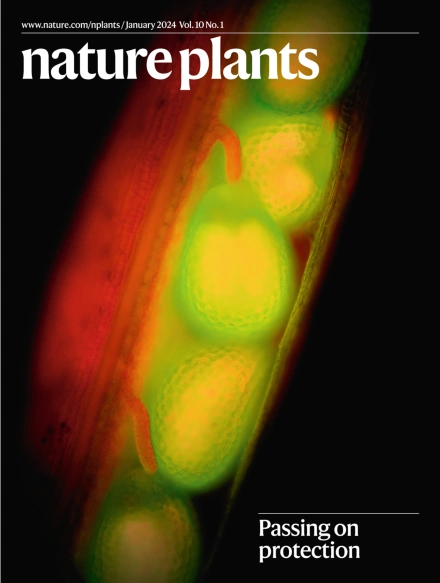Wounding induces multilayered barrier formation in mature leaves via phytohormone signalling and ATML1-mediated epidermal specification
IF 13.6
1区 生物学
Q1 PLANT SCIENCES
引用次数: 0
Abstract
The epidermis of plants forms a protective barrier against biotic and abiotic stress. Little is known about how breaches in the epidermis are repaired, especially in mature leaves. Here we investigated wound healing in the mature leaves of Arabidopsis. We discovered a wound protection mechanism comprising a multilayered ligno-suberized barrier covered with cuticular wax. This barrier is formed by mesophyll cells that adopt an epidermal fate. This cell fate transition is regulated in two steps by ATML1, a key transcription factor in epidermal specification. First, mesophyll cells of protective layer 1, just beneath the wound, transition into epidermal cells and seal the wound by depositing cuticle, a mechanism that involves signalling through ethylene and reactive oxygen species produced by RbohE. This signalling also promotes cell death in protective layer 1, ensuring wax accumulation on the surface. Second, the underlying protective layer 2 undergoes ligno-suberization, driven by jasmonic acid and RbohD, forming a cork-like layer on the leaf surface. ATML1 regulates this process in protective layer 2 as well. Wound healing in mature leaves thus involves the integration of ethylene and jasmonic acid signalling with ATML1-mediated epidermal cell specification to coordinate cell-layer-specific functions, including cuticular wax formation and ligno-suberization. This protective mechanism also occurs in the leaves of tobacco and Capsella, suggesting it is widespread. Arabidopsis repairs leaf wounds by reprogramming mesophyll cells into epidermal-like cells that build a ligno-suberized barrier topped with cuticle. ATML1 directs this process via ethylene–RbohE and jasmonic acid–RbohD signalling across cell layers in space and time.


损伤通过植物激素信号和atml1介导的表皮规范诱导成熟叶片形成多层屏障
植物的表皮形成了抵御生物和非生物胁迫的保护屏障。人们对表皮上的裂缝是如何修复的知之甚少,特别是在成熟的叶子中。本文研究了拟南芥成熟叶片的伤口愈合。我们发现了一种伤口保护机制,它包括一种覆盖着表皮蜡的多层木质化屏障。这种屏障是由采用表皮命运的叶肉细胞形成的。这种细胞命运的转变是由ATML1调控的,ATML1是表皮规范的关键转录因子。首先,位于伤口下方的保护层1的叶肉细胞转变为表皮细胞,并通过沉积角质层来封闭伤口,这一机制涉及通过乙烯和RbohE产生的活性氧发出信号。这种信号也促进了保护层1的细胞死亡,确保了蜡在表面的积累。其次,在茉莉酸和RbohD的作用下,下层保护层2发生木素化,在叶片表面形成软木状保护层。ATML1也在保护层2中调控这一过程。因此,成熟叶片的伤口愈合涉及乙烯和茉莉酸信号与atml1介导的表皮细胞规范的整合,以协调细胞层特异性功能,包括角质层蜡的形成和木素的分化。这种保护机制也存在于烟草和油菜的叶子中,表明它是普遍存在的。
本文章由计算机程序翻译,如有差异,请以英文原文为准。
求助全文
约1分钟内获得全文
求助全文
来源期刊

Nature Plants
PLANT SCIENCES-
CiteScore
25.30
自引率
2.20%
发文量
196
期刊介绍:
Nature Plants is an online-only, monthly journal publishing the best research on plants — from their evolution, development, metabolism and environmental interactions to their societal significance.
 求助内容:
求助内容: 应助结果提醒方式:
应助结果提醒方式:


